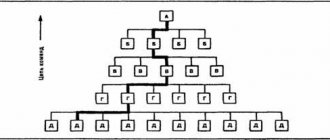Hello! In this article we will talk about one of the most effective time management tools - the Eisenhower matrix.
Today you will learn:
- What is the Eisenhower Matrix;
- How you can apply the matrix in everyday life (with examples);
- What techniques will help you save time?
Creator of the Eisenhower Method
Dwight David Eisenhower was born in 1890 into an ordinary family. In 1909 he graduated from school, then 4 years of study at the military academy. With particular passion, Eisenhower studied the biography of Lincoln and the greats of this world. The parents supported their son in everything. The support of loved ones in his youth would have a positive impact on Eisenhower's career in the future.
Resignation in 1948 did not mark the end of active work. After Eisenhower became rector of the Columbia Institute, and at the beginning of 1953 he took the post of President of the United States - he was later elected to this post several times. The politician faces the question of effective time management, and Eisenhower solves it.
Where is Dwight Eisenhower's principle used?
The described technique for distributing tasks is used not only to rationalize time. Accelerated analysis according to the Eisenhower principle is used, for example, to determine the necessary functions of retail facilities. Improving a product at all stages of its life cycle is called functional cost analysis (FCA). This principle combines economic and technical techniques for determining the relationship between the properties of a product and its costs. The latter must be logical and pay off.
What is the Eisenhower principle in the FSA has been studied by many experts from countries with market economies: France, Germany, Great Britain, and the USA. As a result, it was revealed that in order to determine the range of relevant functions of an object, it is important to maintain proportions between their necessity and cost. The Eisenhower principle in FSA is to analyze a product and distribute its properties into three categories:
- Category A. Main or fundamental functions: the direct purpose of the product, for the provision of which it is necessary to spend a larger amount of money.
- Category B. Secondary functions of the product that are associated with the main ones. The presence of such additions is welcome, but the absence does not affect sales too much.
- Category C. Superfluous functions, the absence of which will in no way affect the quality of the product. By avoiding spending on add-ons that are completely unnecessary, you can save a lot of money.
The Eisenhower Matrix as a method of organizing time
Now we clearly understand that time management is a tool that helps to effectively plan tasks and manage time while saving energy. In the 1950s, Eisenhower did not know this.
The Eisenhower Matrix was created to help solve urgent and important problems. It is not recommended for use in long-term planning, but for daily goal setting, this method has no equal. The simplicity of use makes the Eisenhower pyramid accessible to all people.
Increase productivity and optimize costs by putting the Eisenhower principle into practice. Help yourself get rid of eternal worries and worries.
Use the Eisenhower Matrix as a prioritization tool. Visually, these are 4 quadrants, in each of which tasks for the current day are noted. The main thing is to accurately differentiate them by degree of urgency and importance.
Conventionally, these quadrants are divided into:
- Quadrant A (important and urgent);
- Quadrant B (important and not urgent);
- Quadrant C (not important and urgent);
- Quadrant D (not urgent or important).
“Is it such a simple task to just fit tasks into quadrants?” you might think. This method is really simple, but like anything you need practice to hone your skills.
What is Dwight Eisenhower's matrix?
The Eisenhower square (or time planning principles) is based on the construction of a matrix. The basics of the matrix are the importance axis (abscissa) and the urgency axis (ordinate). Their mutual intersection produces four squares, each of which is filled with tasks according to their distribution.
So, first you need to decide what is important and what is urgent. Important matters have the greatest impact on achieving results, and urgent tasks require immediate completion. In general, a picture is formed that gives a complete picture of the state of affairs.
The matrix will allow you to set the right priorities - what can wait and what cannot be delayed.
Characteristics of quadrants
To help you understand how to fit tasks into the quadrants, below is a detailed explanation for each of them.
Quadrant A (important and urgent)
If this quadrant has 2 or more items daily, pay attention to self-discipline. Ideally, there are no records in this sector. This indicates a person’s organization and active life position. In case of laziness and eternal procrastination “for tomorrow,” quadrant A will always be filled.
Difficulty 2. Why they are not important
Seeing such examples, many are surprised:
— Why are these tasks not important? Are you saying that you don't need to refuel your car? No need to pay taxes?!
No, all this certainly needs to be done. If we don't put gas in the car, it won't go anywhere, and if we don't pay our taxes on time, we could get into trouble.
The difficulty here lies elsewhere:
The need to complete a task does not say anything about its importance.
We can wash dishes all day long, but this is unlikely to make us happier. We can pay our taxes conscientiously, but it won't increase our store's profits one penny.
Tasks from “Square C” do not improve our lives because they are imposed on us from the outside: by the world around us, by circumstances or by other people. They are performed only to maintain the current standard of living and avoid troubles.
Yes, we are forced to react and carry out these tasks. But we would breathe a sigh of relief if our car suddenly began to refuel itself with some kind of cosmic energy, and the dishes began to clean themselves after every meal. In other words, we don’t really need these things in themselves.
A person who sincerely believes such tasks are important falls into a dangerous mental trap. He begins to spend a lot of time and effort on them, hoping that his life will one day improve from this. In fact, he is simply marking time, and his life remains where it was.
This is why Quadrant C tasks are unimportant: by their nature, they are not capable of changing anything.
The truly important things are the things that are directly related to our core goals and values. These are things that change our lives for the better, make us happier, help us move towards our goal and not miss it.
Everyone, naturally, will have their own list of such tasks. For one person it’s an investment in health and self-development, for a second it’s working on their projects, and for a third it’s just time spent with loved ones. What all these tasks have in common is that they are dictated by our personal aspirations, and not imposed on us from the outside.
And here the main danger of “square C” becomes clear.
Our time is limited. There are only 24 hours in a day, and life expectancy, even in the most developed countries, rarely exceeds 80 years. And the more time a person spends on “urgent but not important”, the less time he has left for what is truly important to him.
How to correctly distribute tasks in a table
Let us select the main ones from the above for the convenience of using the Eisenhower method. Distribute tasks in the table according to 4 quadrants:
- Priority important and urgent tasks that must be completed without delay.
- Important but not urgent tasks that should be completed as soon as possible. They have a big impact on the final goal, but they don’t “burn.”
- Unimportant and urgent tasks that are unlikely to affect the positive outcome of something.
- We allow ourselves to do things that are not important or urgent when we want to relax and get distracted.
You will become a master when there is a dash on the list of urgent and important tasks in the A quadrant. Hurry is depressing, doesn’t allow you to catch your breath, and the quality of the completed task often leaves much to be desired. Do not rush to be upset if at first the to-do list in quadrant A is longer than in the other quadrants. You are not the first to learn from your mistakes. Given your experience, in the future you will be able to cope with difficulties and bring the filling of the Eisenhower table to automaticity.
What is included in square D?
For people who do not know how to properly plan time, things in this square take up the most time. These tasks can rather be called not problems, but pleasant worries, which, moreover, bring absolutely no rational benefit. The influence of square D must be, if not eliminated, then at least tried to be reduced.
You should not replace rest with aimless monitoring of social networks, watching TV shows or series, or empty chatter on the phone. You can also spend your free time for the benefit of yourself and those around you: family, loved ones and friends.
How to put the Eisenhower matrix into practice
The time has come to implement the acquired knowledge. You know enough to start using the Eisenhower planning method in your life.
Follow these simple rules to avoid common beginner mistakes:
- It is better to outline a list of tasks in the evening. Decide right away which one is more convenient for you to use. This could be a notepad, a tablet, or the Eisenhower Matrix in Excel on your phone. Even a regular A4 sheet will do. The main thing is that the data is always at hand.
- While you are a beginner, write a list of all your to-dos on a separate sheet of paper and only then enter it into the Eisenhower table. Later, you can skip this point and immediately classify tasks by importance and necessity.
- Read the task list carefully, while asking yourself the question of urgency.
When classifying cases on the Eisenhower Scale, ask yourself:
- Is this task within the realm of my priority values? If the answer is positive, then it is important, if negative, it is not important.
- Will there be negative consequences for me if I don't complete this task? This question will also determine the degree of importance.
- The degree of urgency is determined by the duration of the task's relevance. If it is impossible to complete a task tomorrow, then urgency is paramount.
Be sure to leave free space on your to-do list if you have compiled it on paper. You can supplement it. You need to move tasks unfinished today to your task list for the next day. If you read the article carefully, you understand that unfinished business will be present on the Eisenhower table every day.
Quadrant 1: do it immediately
Quadrant 1 contains tasks that are both urgent and important . These are “do first” things because they are significant to your life or career in some way and need to be done immediately. You feel that these things are critical.
These are things that need to be done to avoid negative consequences . It is important to be able to manage goals in this quadrant of the Eisenhower Matrix.
An example of a Segment 1 mini-goal in your career could be responding to a time-sensitive email from a client.
This matrix can also be used in your personal life. An example of such a function in personal life could be registering a newborn baby, shoulder pain and the requirement to find a massage therapist, or buying tickets for tomorrow's train.
❷
Under what conditions will the Eisenhower Matrix be useful to you?
The matrix helps in planning complex and important tasks. Understand how the method works and apply it to short-term planning.
Feel free to use the Eisenhower table in life if:
- it is difficult to determine the primary task, it is difficult to understand where to start;
- be honest with yourself and truthfully answer questions asked when planning;
- want to optimize time costs;
- you know that you are capable of more, but you don’t understand how to achieve a better result;
- stop putting things off until tomorrow.
In order to achieve results, it is not enough to study the Eisenhower matrix. Only by applying this knowledge in practice will you see the effect.
Why should this method be used?
Dwight Eisenhower's principle can help you change your life in terms of rationalizing your personal time. Using this method allows you to spend less time on unnecessary tasks and do the most promising things, as well as devote enough time to proper rest, avoiding the so-called time wasters: television, aimless wandering through the Internet, and the like.
A person who applies the principles of time management in his daily activities is not only more successful than others, according to statistics, but also healthier, since he does not experience constant stress associated with overload and constant deadlines. Prioritization (the Eisenhower principle or any other) will help you optimize your life activities in all areas.
You may already be good at managing your time.
What if you don't need Eisenhower's methods and are just fine with problems without tables? Ready to decide right now?
Then answer these questions honestly:
- Do you always make a to-do list?
- Do you respond to emails on time?
- Do you go home on time and working on the weekend is not about you?
- Does social media and chatter interfere with important tasks?
- At the end of the day, are you irritable and feeling like you could have done more?
- Do you always pay due attention to your family?
Think about whether you want to change the current state of affairs or leave everything as it is. Eisenhower Table - Your planning assistant.
Quadrant A: important and urgent matters
- Things that, if not completed, jeopardize the achievement of the goal.
- Problems that need to be solved in order to avoid big difficulties in life.
- Health issues.
If you are a monster of efficiency, then this quadrant will be empty for you: you simply will not get things done until you get into the “fire” sector. But you're not an efficiency monster (and neither are we), so that's unlikely to happen. The most important thing is that things happen there infrequently and in small quantities. If half of your task list is there, it’s a disaster.
However, there is no need to panic. In order for this quadrant to be empty, you first need to work on maintaining the other sectors.
A few related tips for organizing and saving time
Use these tips when implementing the Eisenhower Method:
- Don't overload yourself with unimportant things.
- Keep your workplace clean and don’t waste time looking for documents; train yourself to be tidy.
- Try to do important things in the first half of the day, and not in the evening, when activity declines.
- Best the enemy of the good. Take the matter seriously, but without fanaticism.
And one last piece of advice. Choose one direction in which you prefer to understand best. It's impossible to know everything.
Difficulty 1. What are these tasks?
When talking about the “urgent - not important” square, authors often give the following examples of tasks:
- Unnecessary phone calls;
- Meetings forced on us;
- Empty conversations with colleagues;
- Analysis of correspondence;
- Useless meetings, etc.
Looking at these examples, readers frown and think something like this:
- Well, this is some kind of nonsense! Firstly, I personally have very few such tasks. Secondly, it is already clear that these activities waste our time. Was it even worth mentioning such trifles?
No, these examples are not bad at all. The problem is that they are borrowed from popular business literature of the 20th century (for example, Stephen Covey) and describe only some work situations typical of that time.
And, of course, we may not have such situations. But if we look closely at our daily life, we will find that tasks from the “urgent - not important” series usually make up almost the lion’s share of the tasks in our schedule.
Here are more current examples of such tasks:
- Prepare breakfast (lunch, dinner)
- To wash the dishes
- Getting to work and back
- Wash or iron clothes
- Fill up your car, pass a technical inspection, renew your compulsory motor insurance policy
- Pay off a loan or mortgage
- To water flowers
- Submit meter readings
- Pay for telephone, internet, traffic police fines, utilities
- Buy groceries (bread, tea, toilet paper, washing powder)
- Pay taxes
- Buy paper or printer cartridge
- Go to a hairdresser (for a manicure, a makeup artist, a cosmetologist)
- Take your computer (refrigerator, TV, vacuum cleaner) for repair
- Replace a burnt out light bulb, etc., etc.
In other words, these are the most numerous and “indestructible” tasks, the completion of which often takes up most of our personal and working time. And these tasks are truly urgent: their untimely completion can seriously complicate our lives.











